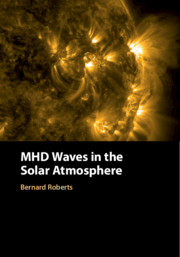3654 results in ebooks in fluid mechanics
13 - Nonlinear Aspects
-
- Book:
- MHD Waves in the Solar Atmosphere
- Published online:
- 15 July 2019
- Print publication:
- 18 July 2019, pp 397-433
-
- Chapter
- Export citation
7 - The Twisted Magnetic Flux Tube
-
- Book:
- MHD Waves in the Solar Atmosphere
- Published online:
- 15 July 2019
- Print publication:
- 18 July 2019, pp 182-206
-
- Chapter
- Export citation
2 - Waves in a Uniform Medium
-
- Book:
- MHD Waves in the Solar Atmosphere
- Published online:
- 15 July 2019
- Print publication:
- 18 July 2019, pp 27-65
-
- Chapter
- Export citation
3 - Magnetically Structured Atmospheres
-
- Book:
- MHD Waves in the Solar Atmosphere
- Published online:
- 15 July 2019
- Print publication:
- 18 July 2019, pp 66-82
-
- Chapter
- Export citation
1 - General Principles
-
- Book:
- MHD Waves in the Solar Atmosphere
- Published online:
- 15 July 2019
- Print publication:
- 18 July 2019, pp 1-26
-
- Chapter
- Export citation
Contents
-
- Book:
- MHD Waves in the Solar Atmosphere
- Published online:
- 15 July 2019
- Print publication:
- 18 July 2019, pp vii-xvi
-
- Chapter
- Export citation

MHD Waves in the Solar Atmosphere
-
- Published online:
- 15 July 2019
- Print publication:
- 18 July 2019
1 - Introductory Concepts
-
- Book:
- An Introduction to Tides
- Published online:
- 08 June 2019
- Print publication:
- 20 June 2019, pp 1-26
-
- Chapter
- Export citation
Contents
-
- Book:
- An Introduction to Tides
- Published online:
- 08 June 2019
- Print publication:
- 20 June 2019, pp v-vii
-
- Chapter
- Export citation
4 - Tidal Constituents and the Harmonic Method
-
- Book:
- An Introduction to Tides
- Published online:
- 08 June 2019
- Print publication:
- 20 June 2019, pp 60-86
-
- Chapter
- Export citation
Appendix A - Mathematical Formulae
-
- Book:
- An Introduction to Tides
- Published online:
- 08 June 2019
- Print publication:
- 20 June 2019, pp 201-201
-
- Chapter
- Export citation
Index
-
- Book:
- An Introduction to Tides
- Published online:
- 08 June 2019
- Print publication:
- 20 June 2019, pp 211-214
-
- Chapter
- Export citation
Acknowledgements
-
- Book:
- An Introduction to Tides
- Published online:
- 08 June 2019
- Print publication:
- 20 June 2019, pp viii-viii
-
- Chapter
- Export citation
2 - Tidal Forcing
-
- Book:
- An Introduction to Tides
- Published online:
- 08 June 2019
- Print publication:
- 20 June 2019, pp 27-41
-
- Chapter
- Export citation
5 - Tidal Wave Propagation
-
- Book:
- An Introduction to Tides
- Published online:
- 08 June 2019
- Print publication:
- 20 June 2019, pp 87-121
-
- Chapter
- Export citation
3 - Celestial Motions
-
- Book:
- An Introduction to Tides
- Published online:
- 08 June 2019
- Print publication:
- 20 June 2019, pp 42-59
-
- Chapter
- Export citation
Appendix B - Depth-Averaged Shallow-Water Equations
-
- Book:
- An Introduction to Tides
- Published online:
- 08 June 2019
- Print publication:
- 20 June 2019, pp 202-204
-
- Chapter
- Export citation
References
-
- Book:
- An Introduction to Tides
- Published online:
- 08 June 2019
- Print publication:
- 20 June 2019, pp 205-210
-
- Chapter
- Export citation
6 - Tides in Coastal Seas and Basins
-
- Book:
- An Introduction to Tides
- Published online:
- 08 June 2019
- Print publication:
- 20 June 2019, pp 122-156
-
- Chapter
- Export citation
Frontmatter
-
- Book:
- An Introduction to Tides
- Published online:
- 08 June 2019
- Print publication:
- 20 June 2019, pp i-iv
-
- Chapter
- Export citation
